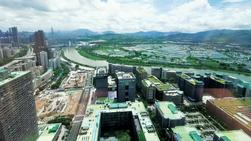 A bird’s-eye view of the bonded zone in Shenzhen’s Futian district, part of the Hong Kong-Shenzhen Innovation and Technology Park, is seen. (CHAI HUA / CHINA DAILY)
A bird’s-eye view of the bonded zone in Shenzhen’s Futian district, part of the Hong Kong-Shenzhen Innovation and Technology Park, is seen. (CHAI HUA / CHINA DAILY)
Leading Hong Kong scientists and experts believe the city and Shenzhen — the twin engines of the Guangdong-Hong Kong-Macao Greater Bay Area — have what it takes to draw on each other’s strengths to bolster the region’s innovation-driven development and overall integration.
“Hong Kong and Shenzhen, an important engine of the Bay Area as described by President Xi Jinping in the speech, are pioneers and trailblazers in the Fourth Industrial Revolution,” Chan Ching-chuen, Hong Kong’s first academician of the Chinese Academy of Engineering, told China Daily.
The leading scientist cited prestigious universities, research and development centers, multinationals and startups, as well as finance, as the “four key factors” to build the Bay Area into a world-class technology powerhouse that promotes originality, inspires creativity, and encourages innovation.
“Hong Kong’s competitive edge lies in finance and universities, but the Asian financial hub has long been restricted by a lack of research centers, a vast market, a vibrant startup scene and large enterprises,” said Chan, who also is founding president of the World Electric Vehicle Association.
“From this point, Hong Kong is highly complementary to Shenzhen and the other nine cities across the Bay Area,” Chan said. “The cooperation between Hong Kong and Shenzhen is deeper than ever, as they share a common future, and that makes each other’s interests inseparable and interdependent. It is the collaboration that gives full play to advantages of the ‘one country, two systems’ principle.”
Chan said he hopes the deeper cooperation between the two cities can make the Bay Area a birthplace of original theories, a technological base from which the theories get off the ground, and the first stop where the theories can be applied and exported to other parts of China and across the globe.
Chan is now working on the integration of four networks (energy, information, transportation and humanities) and four flows (energy, information, material and value) — an original theory that may capitalize on the region’s synergy to essentially help the country lead the pack in the Fourth Industrial Revolution.
Shenzhen is indeed a “major engine” of the Bay Area, but more than one engine is needed to push the region forward, said Leung Chun-ying, a vice-chairman of the National Committee of the Chinese People’s Political Consultative Conference and a former chief executive of the Hong Kong Special Administrative Region.
“Hong Kong is another engine, exerting its leading power in international finance services, international trade services and international profession services,” Leung said. “Plus, Hong Kong has excelled at third-party trade. Our large trading volume says a lot.”
“The fast development of Shenzhen will provide ample opportunities for Hong Kong,” Leung said. But Hong Kong is also very competitive on intellectual property rights, on which the SAR’s innovation and technology sector relies heavily, Leung added.
“Given the rule of law and the use of the common law system, Hong Kong can also be a very useful platform for Shenzhen companies to buy and sell intellectual property rights, especially in the international markets,” he said.
Leung is upbeat about the future collaborations between Hong Kong and Shenzhen across a range of sectors. But to make these happen, they must “lower or remove the barriers between the two cities to facilitate easier movements of suppliers and customers of goods and services,” Leung said.
Tech and innovation
Technology and innovation have a place of pride in Xi’s speech. He called for meticulous planning in the construction of the Hong Kong-Shenzhen Innovation and Technology Park in the Lok Ma Chau Loop.
“The location of the park, which is very close to Shenzhen, will make it very convenient for Shenzhen experts to commute daily to work with their Hong Kong and international counterparts,” Leung said. “The park will combine the research capabilities of Hong Kong with the application and production prowess of Shenzhen.”
Chow Pak-chin, deputy director of the Guangdong-Hong Kong-Macau Ophthalmologists Alliance, acknowledges that youth exchanges between Hong Kong and the Chinese mainland are vital, particularly in the medical field, and are a starting point for cross-boundary medical collaboration.
Medical practitioners in Shenzhen have ample experience under their belt, as they deal with various and varied medical cases every day. “Their know-how provides a valuable textbook for Hong Kong medical professionals to pick up. Practice makes perfect, which is particularly true in the medical profession,” Chow said.
“A months-long exchange program allows our Hong Kong youth to live, study, work and make friends in the mainland city so that they can have a better knowledge of our country. Getting a real and impartial picture of our country is key to patriotism.”
Shenzhen’s development in all aspects, including the medical industry, at lightning speed also acts as a catalyst and motivator for Hong Kong’s advancement, Chow said. “Watching our surrounding cities grow big and strong, we will feel more driven to do our bit for the Bay Area development,” he said.
Hong Kong has been widely recognized for its tried-and-true regulatory framework for medical specialists and a sound physician-patient relationship mediated by the Medical Council of Hong Kong, and that should be leveraged in medical collaboration with Shenzhen and other Bay Area cities, Chow said.
While collaboration between Hong Kong’s universities and Shenzhen’s renowned hospitals has been underway, there lacks a systematic framework standardizing the cross-boundary arrangements, Chow said. “There are discrepancies in healthcare and medical policies between Hong Kong and the Chinese mainland. So we need to hammer out a solution applicable to both sides,” he said. “We can test the waters in the Lok Ma Chau Loop as a start.”
Contact the writers at sophia@chinadailyhk.com


